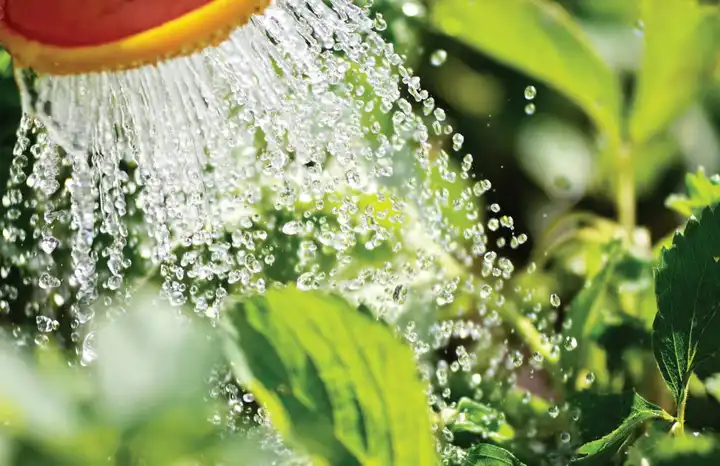
3 minute read
Blooming Times
Plant SOS!
If the recent drought reduced your garden to a dustbowl full of dead twigs, don’t panic, says Flo Whitaker. All is (probably) not lost…


In heatwave conditions, it’s often potted plants that suffer most. If you’ve ever tried re-wetting a pot of dry soil, you’ll know how difficult it is – the water gushes through in seconds without touching the soil. Unlikely as it seems, a mild detergent will help. A few drops of washing-up liquid stirred into a can of water reduces the water’s surface tension, helping it cling to soil particles (a tiny quantity of detergent won’t harm plants).
If the pot is small, plunge it into a bucket of water. You’ll notice air bubbles escaping from the compost. Weigh the pot down with a brick, keeping it fully submerged until the bubbling stops. This method is particularly useful for unglazed ceramics, as bonedry terracotta sucks moisture from compost, adding additional stress to roots.
Stand larger pots overnight in deep, water-filled containers, such as washingup bowls. Gently scrape the soil surface the following day and check the moisture has migrated fully through the soil. If all else fails, the only solution may be to carefully excavate the plant, soak the rootball until wringing wet, then repot. This is undoubtedly a faff, and I wouldn’t bother doing it with temporary bedding plants, but if you have a particularly cherished specimen or an expensive shrub, it’s worth making the effort.
Drought-stressed shrubs often employ an alarming survival technique of dropping their leaves, then entering
a dormancy period. How to tell if the plant is merely ‘hibernating’, or has died? Select a stem and scrape away a small area of bark. If the tissue underneath is moist, with a white/cream or green hue, it’s alive. If brown-ish, dull and dry, it’s probably beyond help. Conifers are particularly susceptible to drought conditions and often succumb. However, some plants will regenerate from apparently ‘dead’ wood. In particular, deciduous shrubs can remain dormant for months, so don’t



start radically chopping back just yet. Wait until next April/May for signs of life – you could be pleasantly surprised. Plants that peak in autumn, (dahlias, asters, chrysanthemums, etc.) may have run out of steam early, as they require moist soil throughout summer to power their spectacular late-season displays. Leave well alone – they will recover and start into growth next year.
Grass is our planet’s most robust plant and a parched lawn will green up within days of rainfall. Before the weather turns frosty, rake out dead grass and moss, which will help prevent fungal infections taking hold. Due to our warming climate, lawns often grow during winter, (grass only requires a temperature of 6°C to trigger active growth.) Should you need to mow during winter, set mower blades to the highest level, remove clippings and don’t expect a perfect cut – a light tidyup is all that’s required. l
SOUTH EAST GARAGEDOORS
Innovative garage door solutions. . . . . .from a local family firm you can trust
Roller Doors
Wood Effect Doors Electric Doors
Sectional Doors
Full installation service • Garage door repairs Electric conversions • Senior citizen discounts
Call us for a free quote 01435 277998 01323 287990











